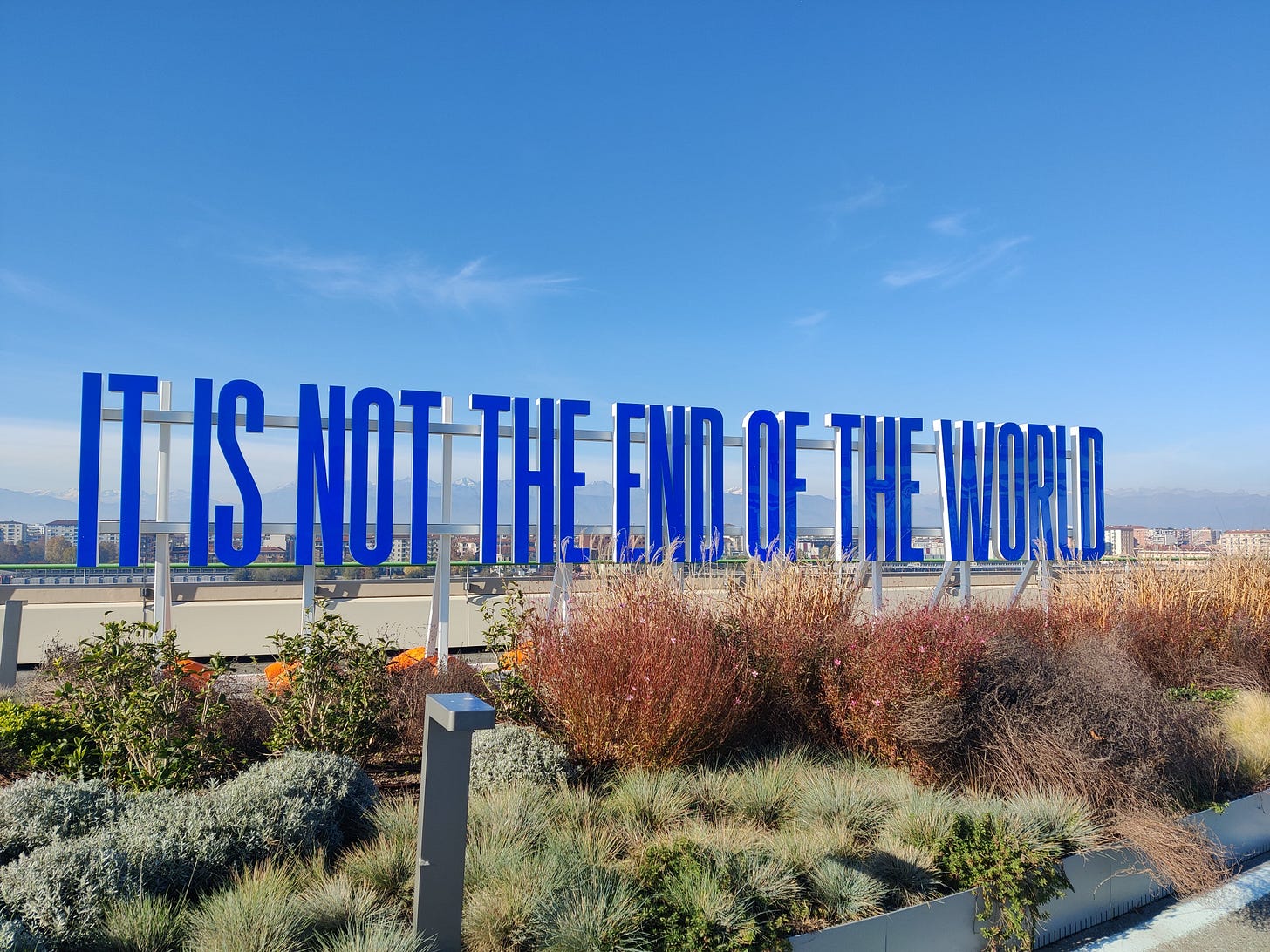The Heat Is On
Earth continues to warm but policymakers stay chilled
As I started working on this week’s issue, I was alerted to the latest news from the European Union’s Copernicus Climate Change Service: the past 12 months saw the Earth experiencing its highest temperatures on record.
Not only that, global temperatures were 1.52°C above pre-industrial times, surpassing the 1.5°C threshold we had hoped to stay under as per the Paris climate agreement. Scientists have warned that every tenth of a degree of warming brings us closer to catastrophic climate change, which could devastate lives and harvests.
I’d like to think this would give a much-needed jolt to the powers-that-be, but in a week full of short-sighted decisions by the European Commission - more below - I’m not holding my breath.
The oversimplification of the European farmers’ protests also continue to frustrate me, so I went on a little rant, essentially rehashing my arguments from last week’s newsletter. If you have the stomach for more, check out my LinkedIn post and X-thread (formerly Twitter).
Breaking Bad Records
Copernicus’ newsflash on Thursday has more alarming information. Here’s a short breakdown -
January 2024 was the warmest January on record globally.
This is the eighth month in a row that is the warmest on record for the respective month of the year.
It was 1.66°C warmer than an estimate of the January average for 1850-1900 (the pre-industrial reference period).
Of course this doesn’t mean the Paris climate goal is now out of reach, as this good Washington Post piece explained, but it is a sign that we are approaching uncharted territory.
This latest update comes a month after Copernicus said, “Global temperatures reached exceptionally high levels in 2023.”
“Unprecedented global temperatures from June onwards led 2023 to become the warmest year on record – overtaking by a large margin 2016, the previous warmest year.”
“2023 marks the first time on record that every day within a year has exceeded 1°C above the 1850-1900 pre-industrial level. Close to 50% of days were more than 1.5°C warmer then the 1850-1900 level, and two days in November were, for the first time, more than 2°C warmer.”
But the EU Continues to Sleepwalk
Tuesday was a big day for the European Commission, the main executive body of the European Union.
It unveiled its recommendation that the EU should slash net greenhouse gas emissions by 90% by 2040. That sounds like an ambitious target right?
Well, yes and no. Why? These two sentences from a Reuters story sum up the issue.
“While the overall target was within the range recommended by the EU's official climate science advisers, the EU executive weakened part of the recommendation concerning agriculture, in response to weeks of protests by farmers angry about EU green rules, among other complaints.”
“A previous draft of the EU target, seen by Reuters, had said agriculture would need to cut non-CO2 emissions 30% by 2040 from 2015 levels to comply with the overall climate goal. That was removed from the final draft.”
According to the FAO, the UN food and agriculture agency, agrifood systems accounted for 32% of Europe’s total emissions in 2020. So the policymakers are ignoring the source of a third of the region’s emissions.
Sure, much of these emissions come from pre- and post-production (53%) but those from farming still accounts for about 11% and reductions have stagnated since 2005, the European Environment Agency has said.
Not only that, a special report by the European Court of Auditors in 2021 was scathing about the Commission’s failure to slash emissions despite spending billions of euros under the Common Agricultural Policy (CAP).
“We found that the €100 billion of CAP funds attributed during 2014-2020 to climate action had little impact on agricultural emissions, which have not changed significantly since 2010.”
“Livestock emissions, mainly driven by cattle, represent around half of emissions from agriculture and have been stable since 2010. However, the CAP does not seek to limit livestock numbers; nor does it provide incentives to reduce them. The CAP market measures include promotion of animal products, the consumption of which has not decreased since 2014.”
“The CAP supports farmers who cultivate drained peatlands, which emit 20 % of EU-27 agricultural greenhouse gases.”
Civil society groups like the European Environmental Bureau have also criticised the EC’s recommendation over what they see as an “overreliance on expensive and unproven technologies” like carbon capture and carbon removal to achieve this target.
On the same day, Commission President Ursula von der Leyen announced the withdrawal of the Sustainable Use of Pesticides Regulation (SUR), a key piece of legislation under the Farm to Fork strategy to make European farming fairer, greener, and more sustainable.
The proposal, which would force EU countries to collectively halve the use of pesticides, had been rejected by the Parliament but the EU Council was still trying to keep it alive, and the decision stunned governments, reported euronews.
Of course, the decision was portrayed as a response to the farmer protests, even though this is not a uniform demand, like I wrote last week. The Pesticide Action Network called it a “black day for health and biodiversity”.
Despite a $10-Trillion Reward
Perhaps the EC hadn’t read a comprehensive new report from the Food Systems Economics Commission, a group of economists and scientists who have looked into food system economics and found there’s as much as $10 trillion to be gained by our food systems becoming more sustainable.
Incidentally, the hidden costs of our current food systems on our health, the environment, and society is estimated to be at least $10 trillion a year as well, or about 10% of the global GDP. You can read more in a previous issue of Thin Ink.
Scenario 1:
If we continue this trajectory, by 2050, 640 million people (including 121 million children) will be underweight while obesity will increase by 70% globally.
Increased nitrogen surplus from agriculture and natural land (land that has not been altered or developed for human purposes) will pollute water, destroy biodiversity and undermine public health.
Food systems will continue to drive a third of global greenhouse gas emissions, which will contribute to 2.7 degrees of warming by the end of the century compared to pre-industrial periods.
Scenario 2:
By 2050, undernutrition has been eliminated and cumulatively 174 million lives are saved from premature death.
Farmers in the global food system (around 400 million people) enjoy a sufficient income from their work while a shift to greener production methods reverses biodiversity loss, reduces demand for irrigation water and almost halves nitrogen surplus from agriculture and natural land.
The food system becomes a net carbon sink by 2040.
How do we get to Scenario 2?
The authors recommend five broad priorities - helping people to eat healthier; shifting government support for agriculture from big farmers, monoculture, and intensive farming to all farmers, healthier food, and greener methods; policies that penalise the production of the most damaging foods and make healthy food more affordable; investing in innovation and technology for smallholder farmers; and developing and strengthening safety nets.
So we have a choice: stay with the current system, which isn’t working for so many of us - “our food systems are destroying more value than they create”, the report said - or do some hard work and reap the rewards. What will it be, blue pill or red pill?
Here’s the 20-page executive summary and here’s the 177-page full report. Or just read Agnieszka de Sousa’s piece about the report in Bloomberg.
A Moment for Zen
If you work in this space, whether you’re a journalist, food producer, scientist, advocate, or researcher, it is pretty easy to feel disheartened and exhausted at the direction humanity is heading. I’ve also been hearing more and more of burnouts from people I know, care, and admire.
So I just wanted to say that while we should not let the b**tards grind us down, we should also take better care of ourselves.
Normally I don’t bother with resolutions, but at the end of last year, I read this NYT guest essay which inspired me to come up with three things to live by in 2024: (1) Not to give up the fight, (2) There is no “try”. Only do, (3) Take care of myself more so that I can take care of others more.
The trip to the UK last month - originally to attend and speak at the Oxford Real Farming Conference and then stranded for an extra 17 days - really cemented all of these things for me.
At the ORFC, an organic farmer who received nothing but praise from his peers for his produce and sustainability ethos spoke eloquently of his - and others’ - struggle to balance work and life and the expectations of having to work 80 hours a week. Around the room, I saw many heads nodding in agreement.
The unintentionally extended stay in London also forced me to reckon with the kind of working hours and pressures I’ve been putting myself under and how screwed up my work norms have become.
Having worked from home now for three years, I got used to seeing “an average work day” as putting in at least nine to 10 hours, without commuting and with a half-hour lunch break. So I became really anxious that I was not being productive when I had to commute to work and to meet people in person in London.
It took me a while to realise I *was* working when I was doing those things and that I was building relationships and gaining great insights from having face-to-face discussions.
I also had a chance to reflect on my personal journey over the past nine years and discovered that January/February have become milestone months: I left Bangkok to set up Myanmar Now in Jan 2015, I did an interview that got me looking at food through a systems lens in Jan 2016, I left the Thomson Reuters Foundation and started Thin Ink in Jan 2021, and I became a core team member at Lighthouse in Jan 2022.
It made me both grateful and less stressed. So yeah, remember, you’re not alone, and don’t forget to pat yourself on the back from time to time.
Thin’s Pickings
Global Nature Beat - Mike Shanahan
A new-ish newsletter from an old hand who has been working on - and writing about - biodiversity and conservation for over two decades. As the name suggests, this is the newsletter to read if you want to know about the latest news, research, and resources (including job postings) on this topic.
Of Hubris and Feces: The Human Story of Phosphorus - Ambrook Research
Sana Khan reviews Dan Egan’s book on phosphorus, a highly-coveted mineral that has been used as a catalyst for plant growth.
I’m now keen to read the book itself, but perhaps I should first finish the half dozen books currently waiting their turns.
Our Friend is Gone, but He Lives Through Our Resistance in Myanmar - New York Times
This short but devastating documentary isn’t linked to food systems, but to my other love. Petr Low and Corinne van Egeraat asked the loved ones of a deceased artist and political prisoner to write him letters as “an act of remembrance and hope”. Have tissues ready.
As always, please feel free to share this post and send tips and thoughts on mastodon @ThinInk@journa.host, my LinkedIn page, twitter @thinink, or via e-mail thin@thin-ink.net.







Thanks for sharing my newsletter Thin!